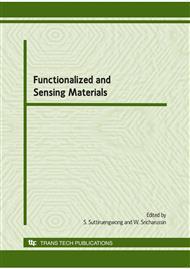p.451
p.455
p.459
p.463
p.467
p.471
p.475
p.479
p.485
Effect of 2-Amino 2-Methyl 1,3 Propanediol on Enteric Properties of Film Prepared from Ammoniated-Based Shellac Composite Salts
Abstract:
The aim of this study was to improve the enteric properties of shellac by composite salt formation with ammonium hydroxide (AMN) and 2-amino-2-methyl-1,3-propanediol (AMD). The shellac films were prepared by dissolving shellac with various combination of AMD:AMN and then characterized for physicochemical and mechanical properties. The results indicated that the solubility of shellac films was increased as increasing proportion of AMD. The percentage of dissolved film at pH 7.0 of 100:0 AMD:AMN (100%AMD) was approximately 3 times higher than that of 0:100 AMD:AMN (100% AMN) while the percentage of dissolved film at pH 1.2 was slightly increased as increasing proportion of AMD. These results suggested the solubility at intestinal pH was improved while the gastric protection was still in the acceptance level. The FTIR spectroscopy of all composite salts demonstrated the peaks at 1716 and 1556 cm-1, which were attributed to the carbonyl stretching of carboxyl and carboxylate groups, respectively. The absorbance ratio of FTIR peaks (ABS1556/ABS1716) was increased with the higher proportion of AMD, suggesting that the solubility enhancement was due to higher ionization degree of AMD salts. The mechanical properties of films were also changed after salt formation. As increasing the AMD:AMN ratio, the percent elongation of films has increased. The result suggested for more flexibility of films. In conclusion, the improved enteric properties of shellac films were achieved after composite salt formation with AMD.
Info:
Periodical:
Pages:
467-470
Citation:
Online since:
January 2010
Keywords:
Price:
Сopyright:
© 2010 Trans Tech Publications Ltd. All Rights Reserved
Share:
Citation:


